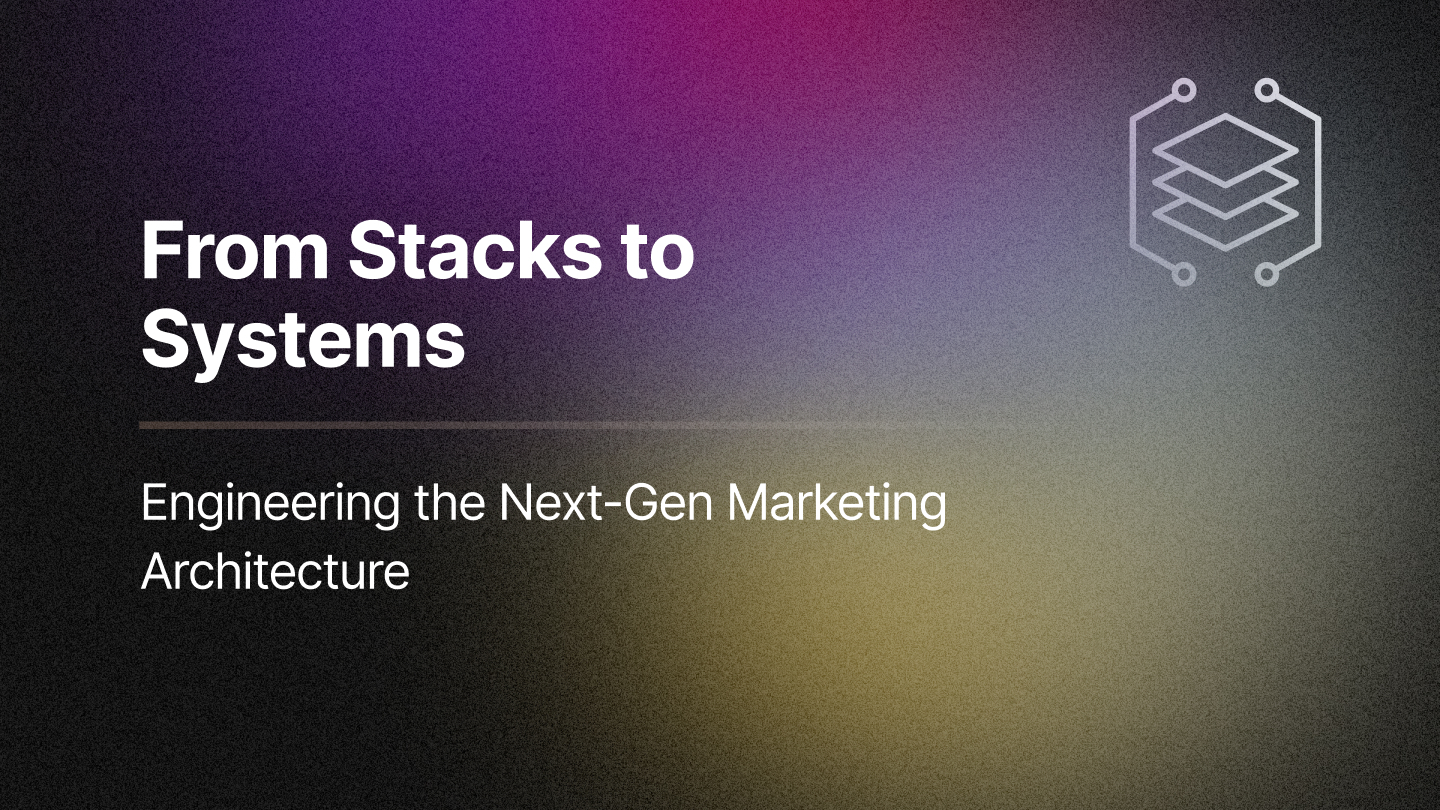In B2B marketing, there's a growing gap between the services offered by digital advertising agencies and the actual needs of modern B2B SaaS marketing teams focused on driving pipeline efficiency. As marketing strategies evolve, B2B companies are no longer content with campaigns that merely generate leads. Instead, they need campaigns that demonstrate a tangible impact on pipeline and revenue.
Most B2B digital agencies structure campaigns to track basic metrics: impressions, clicks, and lead conversions. Whether it’s LinkedIn ads, Google AdWords, or Facebook campaigns, the focus is on generating as much awareness and lead volume as possible. However, the emphasis on top-of-funnel metrics like impressions and leads often comes at the expense of more meaningful, deep-funnel metrics that actually impact business growth. It’s time for marketing teams to demand more.
The Schism: Top-of-Funnel Leads vs. Bottom-of-Funnel Pipeline
A significant divide exists between traditional B2B digital advertising agencies and the requirements of modern SaaS marketing teams. The traditional agency approach is heavily focused on lead generation and top-of-funnel metrics, while today’s B2B marketing teams need campaigns that deliver pipeline impact—that is, qualified opportunities that can eventually convert to revenue.
Here’s how this divide often plays out:
- Agency Approach: Campaigns are designed around driving clicks and conversions to leads. Success is typically measured in terms of lead volume, click-through rates, and other surface-level metrics.
- B2B Marketing Team Requirements: Beyond leads, marketing teams need to understand the quality and potential revenue impact of those leads. They want to track engagements down the funnel, evaluating how campaigns drive opportunities, pipeline, and revenue.
This misalignment can lead to frustration for marketing teams who see leads pouring in but little evidence of impact on pipeline growth. When leads don’t translate into sales-ready opportunities, resources are wasted, and marketing efforts can appear ineffective. The bottom line? High lead volume doesn’t always equate to pipeline growth.
Why Current Campaign Setups Fall Short
Many B2B digital agencies set up campaign tracking to optimize for leads, not pipeline. This setup impacts everything from campaign structure to tracking instrumentation. Here’s how these setups often miss the mark:
- Shallow Attribution: Most agency-run campaigns track the basic progression of a lead—from ad click to form submission. However, they rarely track whether that lead progresses deeper into the funnel, such as moving from lead to marketing-qualified lead (MQL), then to sales-qualified lead (SQL), and finally, into the pipeline.
- Misalignment in UTM Tracking: The use of UTM parameters (which help track where web traffic originates) is typically focused on identifying broad lead sources, like LinkedIn or Google Ads. However, UTMs are often not configured to align with the company’s own internal campaign tracking, leading to discrepancies between agency metrics and internal marketing data. This misalignment causes significant challenges when trying to understand which campaigns are actually generating pipeline.
- Limited Focus on Pipeline & Revenue Attribution: Agencies often don’t account for how campaigns contribute to pipeline & revenue. Leads may enter the funnel, but without tracking their journey to closed-won status, it’s impossible to assess whether campaigns are delivering ROI. For B2B marketers focused on revenue growth, tracking spend against pipeline creation and revenue generation is critical.
- No Emphasis on Buyer Journey Insights: Understanding where leads drop off or convert in the buyer journey is crucial for refining campaign strategies. Traditional setups often lack the ability to measure these touchpoints or provide insights into where prospects are in the decision-making process.

These shortcomings create a disconnect between what agencies measure and what B2B marketers actually need to drive growth. For B2B SaaS marketing teams, the focus should be on campaigns that don’t just deliver leads but rather generate sales-ready opportunities that contribute to the pipeline.
The Need for Pipeline-Centric Campaign Tracking
To close the gap between agency performance metrics and true pipeline impact, B2B marketing teams must begin to demand a more sophisticated approach. Pipeline-centric campaign tracking requires changes to both the way campaigns are set up and how their performance is measured.
Key changes that agencies need to adopt to better support B2B pipeline goals include:
- Align Campaign Tracking with Pipeline Stages: Campaign tracking should extend beyond leads and track progression into stages like MQL, SQL, and Opportunity. This alignment provides visibility into the funnel and helps marketers understand which campaigns truly drive the pipeline.
- Improve UTM Consistency Across Systems: Campaign names and UTM parameters should align with internal company tracking structures, making it easier for marketing teams to integrate agency data into their internal reporting. This also helps sales teams follow leads through the pipeline, linking back to specific campaigns.
- Shift from Volume to include Value Metrics: Instead of focusing solely on lead volume, agencies should track metrics that demonstrate pipeline impact, such as cost per SQL, opportunity creation rate, and projected revenue impact. These metrics provide a clearer picture of how campaigns drive business growth, not just top-of-funnel activity.
- Enable Pipeline & Revenue Attribution: The ultimate goal of any B2B marketing initiative is to contribute to revenue. Agencies need to adopt revenue attribution practices, showing how each campaign influences pipeline and revenue. By mapping spend to revenue contribution, agencies can provide more meaningful insights that justify marketing investments.
B2B Marketing Teams: Start Demanding Pipeline Impact
If B2B marketing teams want to maximize ROI, it’s essential to hold digital agencies accountable for pipeline performance, not just lead generation. Here’s what marketing teams can do to ensure their agency partnerships support true pipeline growth:
- Set Clear Expectations for Pipeline Tracking: During campaign setup, make it clear that the goal is not just leads but a qualified pipeline. Outline specific metrics to track at each stage of the funnel and insist on tracking consistency.
- Prioritize Alignment on UTM Parameters and Campaign Names: Collaborate with your agency to ensure that all campaign tracking, including UTM parameters, aligns with internal tracking systems. This alignment makes it easier to track campaign impact down the funnel and provides consistency across systems.
- Request Revenue-Based Metrics: Ask agencies to report on deeper metrics, such as cost per opportunity or cost per dollar of revenue. This approach incentivizes the agency to focus on creating high-quality leads that are more likely to convert to revenue.
- Integrate Campaign Data with CRM and Attribution Tools: Consider investing in CRM and attribution tools that help link agency campaign data to internal pipeline metrics. By integrating this data, marketing teams gain a more accurate view of which campaigns and touchpoints drive results across the entire buyer journey.
Moving Forward: A Demand for Results-Driven Partnerships
In today’s B2B landscape, simply generating leads is no longer enough. Marketing teams are under pressure to show how their efforts directly impact revenue and justify their budgets. To meet these demands, marketing teams must demand more from their digital agencies—specifically, a pipeline-focused approach that tracks spend, performance, and impact across the entire funnel.
If agencies can evolve to meet these expectations, both they and the B2B marketing teams they serve will see stronger results and more impactful outcomes. In the end, a partnership focused on pipeline impact, rather than lead volume, benefits everyone involved and ultimately drives more sustainable growth.
It’s time for B2B marketing teams to demand more pipeline, not just leads.
Related Blogs








